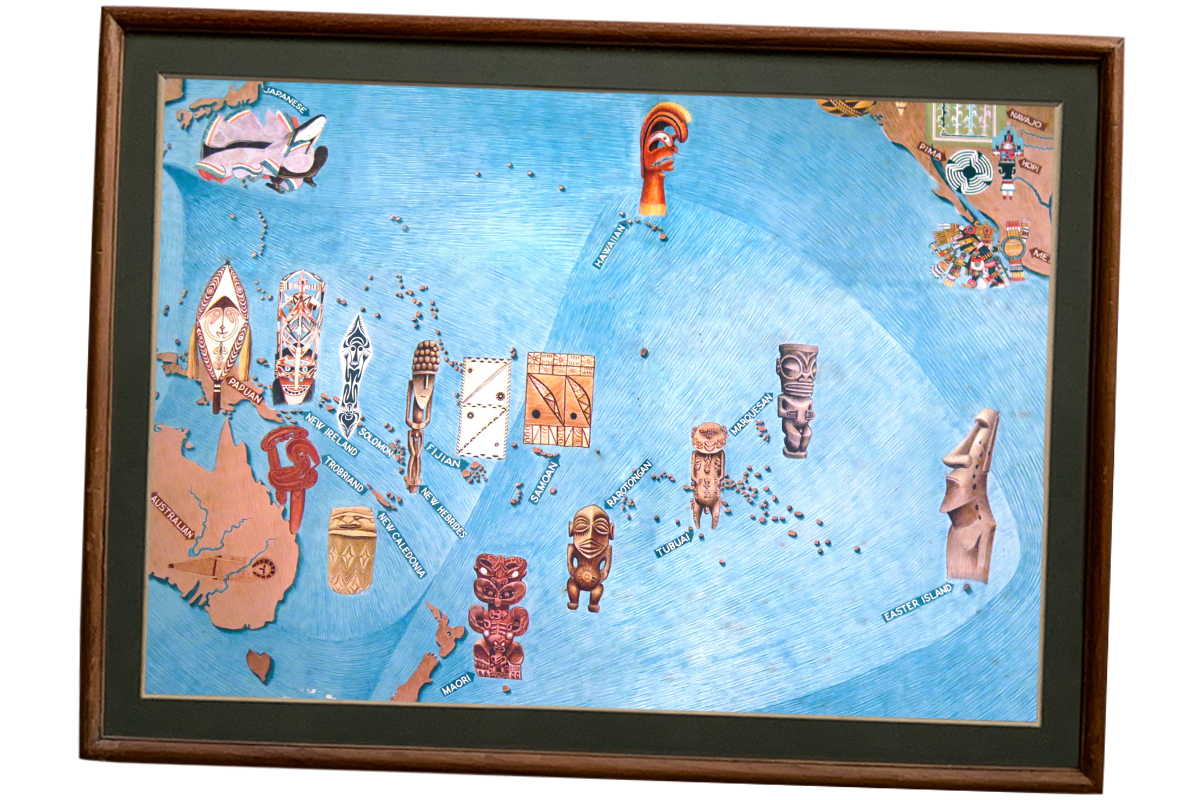
Sven Kirsten
„… was conceived on a freighter of his grandfather’s Hamburg-Chicago Line. Following the call of the big world, he moved to California at the age of 25. Kirsten studied at the American Film Institute in Los Angeles and began shooting music videos in the late 1980s for The Cramps, Tom Waits, Sergio Mendes, and others. After years of hunting down pieces of the puzzle of Polynesian Pop, Kirsten has developed a singular insight into the Cult of Tiki, and he has become the country’s most eminent Tiki archaeologist…“
Cinematographer Sven Kirsten is the author of the “The Book of Tiki” which is widely acknowledged as the bible, and several other publications have deepened the research on his favorite subject of Polynesian pop culture. „Tiki Modern“ explores the Tiki style with mid-century modernism, and „Tiki Pop“ is the complete chronicles of America’s obsession with Polynesia. His most recent book, „The Art of Tiki“ is a passionate study of the Tiki idol as an art form. For the first time, contemporary Tiki art is united and presented equally with what inspired it, original mid-century Polynesian pop.
The Story of Tiki

„Anyone who has ever seen them is thereafter haunted as if by a feverish dream.“
Karl Woermann, (venerable art historian, about Oceanic statuary)
Such are the words of a true Tiki lover. Little did Karl know that 50 years later, his love would be shared by a whole generation of Americans who worshipped the Tiki as their god of recreation.
While bamboo bars and tropical watering holes had been popular in American cities from the 1930s on, it was not until the mid-50s that the Polynesian idol commonly called the Tiki became the ambassador of South Sea escapism. The post-war public’s taste had evolved into a fascination with exotic cultures when Hawaii was about to become a member of the United States. Art and sculpture were utilized to decorate Polynesian-style bars and restaurants.
In doing so, American proprietors and their designers used their own imagination to embellish the traditional tribal models, and a new pop-culture was born. The whimsical Tiki image proliferated in the form of statues, motel signs, menu covers, and cocktail mugs. The contrast of primitive-looking Tiki carvings with mid-century modernism provided unique esthetic friction, unlike any design style before it.
After Tiki fell out of fashion in the 1980s, urban archeologists unearthed its remnants piece by piece, gradually resurrecting the forgotten culture. Invigorated by the craft cocktail revival, a new generation of Tiki lovers is now partaking in its primal spirit in new Tiki hideaways all over the world.
How to Tiki in the 21st Century
While Tiki style is based on a fantasy, it is not a free-for-all of exotic influences. Modern Tiki has a lot of leeways to play with pop culture ideas, but an authentic Tiki environment should always be recognizable as such. This means first of all that the figure of the Tiki, in carved and in rendered form, should be present. A bar does not become a Tiki bar just because it serves Tiki cocktails.
The Tiki lover knows his Tiki STYLES. Modern artists were not concerned with the mythology but with the ART of Oceanic sculpture, inspired by the creativity of how the original island sculptors rendered the human form in a myriad of ways. The different islands of the Polynesian triangle brought forth different forms of Tikis (see Covarrubias map below).
Ultimately, the goal of the Tiki lover is to create a romantic atmosphere of exotic ports of call on remote tropical islands. These bars were decorated with souvenirs and mementos that sailors brought back from their travels in the South Seas, from mythical lands of strange rituals and beautiful wahines.
For this, nautical props like ship models, pufferfish, and beachcomber lamps are a helpful addition. Maps and travel posters, weapons, shrunken heads, and images of island maidens flesh out the mood. Even the occasional Asian or African souvenir is not out of place – as long as the predominant theme is that of the South Sea island paradise. This is where Tiki and the Tiki lover feel at home.
The Circle Of Tiki
A guide for those who want to know which elements make a bar into a Tiki bar. Very simply put, a Tiki bar distinguishes itself from generic tropical bars by using the Tiki figure as its main theme. This is the main fact that makes it unique among 20th Century décor concepts.
Main Tiki Bar Elements (around 50 %)
Carvings and art from Polynesia like Tiki statues, posters, mugs, weapons, masks, Tiki utensils, ashtrays, Tiki lighters, menus, matches, and other objects and art that depict Tiki (Polynesian ancestor figures). Also: Artefacts from Melanesia (Papua New Guinea) and Micronesia. Architecture like A-Frame meeting houses.
All these elements can show the influences of three additional stylistic forces. In the pie chart, you see three triangles that influence original mid-century Tiki art as well as today’s revival Tiki style.
They are: 1.) Original Pacific art 2.) Modernism & Picasso and 3.) Cartoons
Supporting Tiki Elements
(10 – 20 % each, depending on your preferences)
These are split into four categories. Exotica, Pre-Tiki, Nautical and Mid-Century Pop.
- EXOTICA – Explorers, Headhunters, voodoo, African and Asian souvenirs.
- PRE-TIKI – Hawaiiana, South Sea movies, Hula girls, Luau imagery, Palm trees, rattan, and tapa.
- NAUTICAL – Trader and Beachcomber style, ship models, ship wheels, anchors, fishnet floats, shells, pufferfish, nets, travel, and adventure objects and Kon-Tiki related stuff.
- MID-CENTURY POP – Surf, Beach, Lounge and Bar elements, Rumpus Room items.
The focus on the main elements is important, with a nice mix of the supporting ideas. On the borders, but outside of Tiki style, are personal preferences like Pirates, Shriners, Rock-a-billy, Monsters, or Star Wars décor. You find these things in modern Tiki bars, even if they are obviously not authentic. To each his own: The Tiki genre is very creative, open, and playful, yet it does have its heritage and history.

